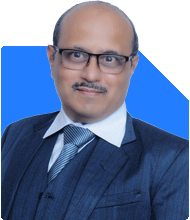Salaried income ₹80,000, but ₹40,000 goes to EMIs. How to invest for the next 5-7 years?
Ramalingam Kalirajan |10893 Answers |Ask -Follow
Mutual Funds, Financial Planning Expert - Answered on Feb 07, 2025
He has an MBA in finance from the University of Madras and is a certified financial planner.
He is the director and chief financial planner at Holistic Investment, a Chennai-based firm that offers financial planning and wealth management advice.... more

Salaried income net 80000. EMIs for Car loan and personal loan is Rs.40000/-. Monthly expenses about 20000/-. Retirement in 2031. No FD or PPF. EPF of Rs.1800pm only deduction from salary. Son in class 10th. Daughter in 7th. Living in father's property. What kind of investment plan I should adopt for 5 to 7 years.
Current Financial Situation
Monthly income: Rs. 80,000
Loan EMIs: Rs. 40,000
Household expenses: Rs. 20,000
Net savings potential: Rs. 20,000
No fixed deposits or PPF investments
EPF deduction: Rs. 1,800 per month
Living in a family-owned house
Key Financial Priorities
Clearing personal and car loans before retirement
Building an education fund for children
Creating a retirement corpus for post-2031 expenses
Ensuring sufficient liquidity for emergencies
Debt Repayment Strategy
Loans take up 50% of your income.
Prepayment of personal loan should be a priority.
Car loans should be cleared before retirement.
Reducing debt improves future investment capacity.
Emergency Fund Creation
At least 6 months' expenses should be set aside.
The fund should cover loan EMIs and essentials.
Investing in safe, liquid instruments is ideal.
Investment Plan for 5-7 Years
A mix of growth and stability is needed.
Mid-cap and small-cap exposure should be limited.
Actively managed funds offer better returns than index funds.
Debt investments ensure safety for short-term goals.
A combination of equity and hybrid funds can balance risk.
Education Planning for Children
Your son will need funds in 2-3 years.
Your daughter will need funds in 6-8 years.
A mix of equity and debt can provide growth with stability.
Avoiding high-risk investments ensures goal fulfillment.
Retirement Planning Approach
Your EPF contribution is minimal.
A dedicated retirement corpus must be created.
Investments should provide returns that beat inflation.
Structured investment through a Certified Financial Planner ensures stability.
Avoiding Direct Mutual Funds
Direct plans lack professional oversight.
A Certified Financial Planner helps manage risk better.
Regular funds offer expert-driven investment choices.
Portfolio rebalancing is essential for long-term success.
Taxation Considerations
Long-term capital gains above Rs. 1.25 lakh are taxed at 12.5%.
Short-term gains attract a 20% tax.
Debt fund taxation depends on your income tax slab.
Efficient tax planning ensures maximum post-tax returns.
Finally
Debt clearance should be a top priority.
Education funds must be secured with a balanced approach.
Retirement investments should be structured for stability.
Market corrections can be used for additional investments.
Consulting a Certified Financial Planner ensures a structured financial journey.
Best Regards,
K. Ramalingam, MBA, CFP,
Chief Financial Planner,
www.holisticinvestment.in
https://www.youtube.com/@HolisticInvestment
You may like to see similar questions and answers below
Ramalingam Kalirajan |10893 Answers |Ask -Follow
Mutual Funds, Financial Planning Expert - Answered on Jul 17, 2024
Ramalingam Kalirajan |10893 Answers |Ask -Follow
Mutual Funds, Financial Planning Expert - Answered on Jun 21, 2024
Ramalingam Kalirajan |10893 Answers |Ask -Follow
Mutual Funds, Financial Planning Expert - Answered on Aug 12, 2024
Nitin Narkhede | Answer |Ask -Follow
MF, PF Expert - Answered on May 25, 2025
Ramalingam Kalirajan |10893 Answers |Ask -Follow
Mutual Funds, Financial Planning Expert - Answered on Dec 15, 2025
Ramalingam Kalirajan |10893 Answers |Ask -Follow
Mutual Funds, Financial Planning Expert - Answered on Dec 15, 2025
Radheshyam Zanwar |6746 Answers |Ask -Follow
MHT-CET, IIT-JEE, NEET-UG Expert - Answered on Dec 15, 2025
Ramalingam Kalirajan |10893 Answers |Ask -Follow
Mutual Funds, Financial Planning Expert - Answered on Dec 15, 2025
Ramalingam Kalirajan |10893 Answers |Ask -Follow
Mutual Funds, Financial Planning Expert - Answered on Dec 15, 2025
Ramalingam Kalirajan |10893 Answers |Ask -Follow
Mutual Funds, Financial Planning Expert - Answered on Dec 15, 2025
Samraat Jadhav |2508 Answers |Ask -Follow
Stock Market Expert - Answered on Dec 15, 2025
Ramalingam Kalirajan |10893 Answers |Ask -Follow
Mutual Funds, Financial Planning Expert - Answered on Dec 15, 2025
Reetika Sharma |425 Answers |Ask -Follow
Financial Planner, MF and Insurance Expert - Answered on Dec 15, 2025
Radheshyam Zanwar |6746 Answers |Ask -Follow
MHT-CET, IIT-JEE, NEET-UG Expert - Answered on Dec 15, 2025

























